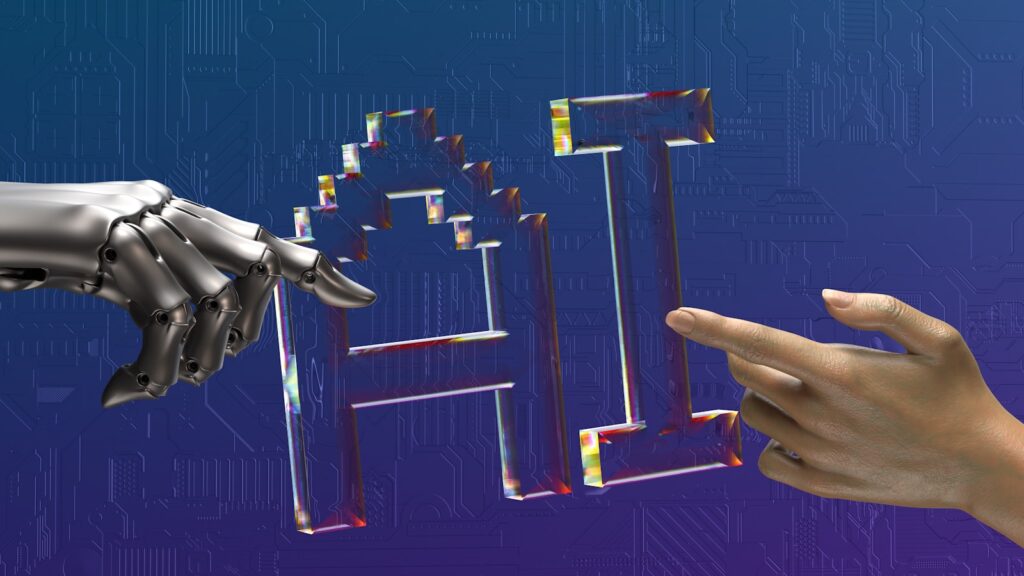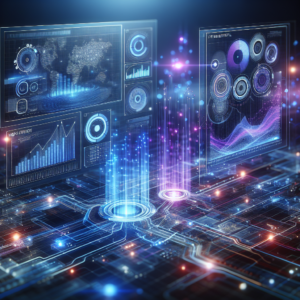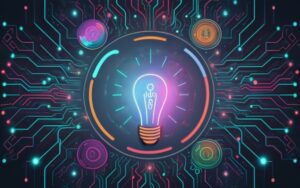This article explores practical strategies in the future of work: embrace AI and automation for organizations and individuals
- to smoothly adapt to an automated future of work powered by artificial intelligence (AI)
- and algorithmic systems that will transform how jobs are performed,
- requiring displaced workforces to reskill and focus on uniquely human strengths like creativity
- while leaders redesign collaborative processes,
- assess operational readiness,
- and invest in continuous skills development programs as machines handle routine tasks –
- ultimately emphasizing that constructive choices valuing worker welfare allow the promise of expanded innovation,
- economic growth and job creation unlocked by automation and artificial intelligence to flourish responsibly rather than worsen inequality if proactively planned for with compassion.
Tactical guidance spans building adaptable workforces through retraining initiatives,
- promoting transparency around automation plans while soliciting frontline feedback,
- exploring policy innovations like conditional basic income,
- and profiling real-world case studies documenting successful examples of synergistic human-AI collaboration across manufacturing, professional services, and retail sectors.

Introduction to the Future of Work:Embrace Ai and Automation
The new era of the rapid advancement of artificial intelligence (AI) and automation stands to profoundly reshape the future of work. As machines take on more complex cognitive tasks once exclusive to human knowledge workers, concerns arise regarding technological unemployment. However, history shows that automation ultimately creates more prosperity than it destroys. The real challenge lies in smoothly navigating workforce transitions in the interim.
The pace of recent innovations in machine learning, computer vision, and natural language processing enables a new generation of capable AI systems. By analyzing vast datasets, these technologies can generate human-like creative output, converse fluently, and even diagnose patients with accuracy rivaling medical experts.
Combined with robotic process automation (RPA) streamlining business operations, AI unlocks the immense potential to augment human productivity and drive economic growth. However, as automation increasingly substitutes labor, certain occupations will face declining demand even as new job possibilities emerge:
Automation Impact by 2030
| Redundant Roles | Rising Opportunities |
|---|---|
| Data Entry Clerks, Cashiers | AI/Analytics Experts, Content Creators |
| Factory Workers, Drivers | Robot Design/Repair, Cybersecurity |
| Paralegals, Accountants | Healthcare, Renewable Energy |
Organizations must proactively upskill vulnerable workforces and nurture complementary skill sets for the automated future of work. A collaborative, transparent, and ethical approach to implementation further eases this turbulence.
This guide shares frameworks helping organizations and individuals smoothly adapt to automation advances reinventing the workplace.
Understanding Automation's Evolving Role
Before exploring adaptation strategies, we must first demystify what automation and AI mean for work. Automation broadly refers to technology executing tasks previously performed by humans. However, the nature of substitution varies significantly across different waves of innovation.
Differentiating Between Process Automation and Autonomous Systems
Robotic Process Automation (RPA) utilizes predefined rules to automate repetitive, high-volume tasks like payment processing or data entry. However, RPA cannot make complex judgments requiring intelligence.
Alternatively, AI-enabled systems like self-driving cars and medical diagnosis algorithms operate autonomously using deep-learning neural networks. They extrapolate patterns from vast training datasets to make uncannily accurate predictions and decisions independently.
While routine work bears the highest risk from RPA, unpredictable non-routine work still proves challenging for most AI—though rapid progress continues expanding autonomous skill sets.
Jobs and Tasks Most Susceptible to Automation
A recent study analyzing over 2000 work activities found about half contain mostly automatable tasks. These include:
- Data processing and collection
- Highly predictable physical work
- Administrative support functions
Conversely, roles involving expertise application, managing others, and unpredictable environments remain tougher to automate with current-generation technologies.
However, partial automation through augmenting human work will impact a far larger proportion of occupations. Uber supplements its drivers with route optimization algorithms. Lawyers utilize AI tools to sort case evidence. This human-machine collaboration model will soon become the norm across most industries.
Growing Occupational Demand Created by Innovation
The common fear is that new technologies eliminate more jobs than they create. And automation does threaten specific occupations.
However, autonomous systems also fuel economic expansion requiring new specialized labor. Emerging fields such as robotics, big data analytics, AI development, and cybersecurity will see skill shortages and rising compensation.
Moreover, technology investments lift productivity, incomes, and consumer purchase power—all drivers of additional job growth. Constructing a realistic outlook and synthesizing countervailing automation impacts result in more balanced strategic planning in the changing job market.
Building an Adaptable Workforce
While automation drives progress, people remain the heart of the enterprise. Constructive participation of motivated workforces pushes innovation further than machines ever could alone. However, adapting human capabilities alongside exponentially improving AI necessitates rethinking development. Let’s examine some best practices.
Proactive Reskilling
Foreseeing occupations requiring reskilling from partial or full automation allows targeted upskilling. Potentially displaced employees gain marketable skills in emerging digital fields through company-sponsored programs or public resources.
Besides minimizing skill redundancy risk, switching supply boosts diversity within growing areas starved for talent—a win-win for both workers and industries.
Reskilling approaches also promote economic mobility, as vulnerable low-wage earners shift into technical middle-class roles.

Cultivating Complementary Human Strengths
Rather than competing with AI dominance in logical reasoning and computational power, workers should hone distinctly human strengths.
These include:
- Creativity: Generating novel solutions and innovations
- Social skills: Building trust via emotional intelligence
- Judgment: Weighing ethical considerations holistically
Workers who acquire new skills gain enduring value as AI handles routine analytical tasks.
Committing to Continuous Learning
Given the blistering pace of technological change, one-off reskilling programs will not suffice. Workers must embrace cycles of ongoing upskilling through micro-courses, automated virtual training simulations, and peer coaching programs.
Forward-looking companies foster constant capability enhancement via incentives like tuition assistance and dedicated time allowances. Individuals additionally seek growth opportunities outside formal organizational structures.
In the automated future of work, standing still means falling behind. Proactive lifelong learning and adaptability sustain employability amidst this turbulence.
Creating Collaborative Work Environments
Maximizing the combined potential of artificial and human intelligence requires reinventing processes and cultural practices for a hybrid workforce. Rather than simply swapping people with machines, the most sustainable organizations holistically integrate automation.
Redesigning Workflows Alongside Automation
Automating subunit tasks without understanding downstream impacts creates bottlenecks. Take invoice processing—RPA resolves purchase order discrepancies swiftly, but manually approving exception flags still causes delays.
Reimagining entire workflows highlights new handoff points requiring human judgment. Are approvals always essential? Could we shift the exceptions list to finance and eliminate the flagging step? Incorporating stakeholders in redesign nourishes empathy and uncovers hidden assumptions underlying processes.
Promoting Transparency in AI Implementation
Despite competitive secrecy norms, transparency regarding workforce automation remains prudent. Clearly conveying timelines, impacted roles, and support programs preempts morale-sapping speculation churn within rumors.
Moreover, explaining AI assistive capabilities at individual levels calms fears of job replacement. People want to understand whether their computer colleague handles rote data organization so they can focus on situational analysis.
Forthright communication makes the benefits of hybrid augmentation tangible rather than abstract theory.

Incorporating Worker Feedback in Automation Initiatives
Who understands pain points with current workflows better than those actively within them? Tapping this frontline intelligence goldmine positions automation for maximum impact.
Constructive suggestion channels also provide emotional outlets for anxiety—giving people indirect control over future changes. Leadership must then synthesize ideas balancing operational needs, ethics, and associated welfare.
Soliciting ongoing participation makes automation feel collaborative rather than imposed top-down.
Ensuring Responsible and Ethical AI Practices
Despite promising productivity potential, automation also introduces risks like algorithmic bias and customer data vulnerabilities. Corporate self-governance preventing misuse protects both society and enterprise reputations.
Humans must remain accountable for AI systems’ actions—particularly when making impactful decisions over people’s lives. Keeping recognized ethical risk zones manual provides safeguarding checks against unintended harms from pure machine optimization.
Embracing New Opportunities Created by AI and Automation
Beyond making some roles redundant, AI-based automation also spearheads entirely novel industries ripe for human capital investment. Companies and workers capitalizing early on emerging domains unlockIncome growth further counterbalances automation job substitution effects.
Exploring Developing Fields
Automation furnishes foundations enabling new sectors’ formation by exponentially increasing computational power available for innovating engineers.
Areas benefiting include:
- Robotic manufacturing facilities require specialized designers, technicians, and safety supervisors to maintain productivity. Jobs multiply as additional factories get built to meet revitalized domestic demand.
- The exponential growth in collected data now necessitates analytics and machine learning professionals decoding insights for business strategy augmentation. Roles span data engineers constructing pipelines to data translators identifying competitive blind spots.
- Cybersecurity workforce shortages persist despite rising threats against AI intellectual property itself worth protecting. Specialists fluent in adversarial attacks uniquely threaten neural network integrity over classical software.
- Renewable energy construction projects also endure labor scarcity. Electricians wiring solar panels apply familiar skills amidst the sustainability transition. Environmental science provides auxiliary knowledge guiding efficiency optimizations leveraging automation.
In all cases, human strengths complement automated capabilities—directing progress rather than impeding it.
Unlocking Entrepreneurial Creativity
Ambitious individuals also enjoy easier technology access enabling startup founding within bleeding-edge domains.
Cloud computing reduces software barriers to entry for creating apps managed by a few people independently. AI generator tools craft synthetic media assets usable for marketing sites and social media instantly without extensive creative effort. These innovations democratize opportunities once exclusively available to resourced enterprises.
Automation liberates all of society to pursue inventing products, services, and business models delimited only by human imagination itself. The next generation of category-defining companies is founded by enterprising minds seizing possibilities emerging today from the automated future of work.
Preparing for the Automated Future

While automation unlocks prosperity, the interim workforce transitions still prove disruptive for vulnerable segments absent support systems. Organizations and governments overseeing implementation proactively can smooth this progress.
Assessing Operational Readiness
Enterprises automating tasks piecemeal accumulate enterprise change debt manifesting in unintended bottlenecks. Appointing project management teams provides oversight, including:
- Documenting all processes requiring transformation
- Modeling cumulative cost savings from reduced labor expenditure
- Projecting workforce retraining budgets as occupational needs evolve
- Liaising between developers and affected departments
This bird’s eye visibility allows sequencing rollout phases balancing continuity assurance with capturing quick wins and sustaining stakeholder confidence.
Structuring Transition Assistance Programs
Displaced workers need robust safety nets given automation’s creative destruction. Assistance options include:
Income protection through short-term stipends substituting lost wages until completing reskilling enrollments
Talent transition programs via partnerships with recruitment agencies to place workers in market-demand-aligned jobs
Mobility support through relocation allowances incentivizes filling talent gaps geographically
Smart combinations smooth out kinks in the reallocation engine dynamically matching human capital to emerging skills in demand.
Exploring Innovative Policy Solutions
As automation reaches insertion across entire economies, more unconventional ideas buffer households from volatility.
Conditional basic income programs provide funds only to those made technologically redundant, sustaining dignity rather than encouraging voluntary workforce departure.
Wage insurance replaces a percentage of lost income for those switching to lower-paying replacement jobs. This cushions downward mobility triggered through the minimal fault of the employees themselves.
Policy experimentation quantifies feasibility as a policy tool managing fluctuations introduced by automation and innovation cycles into labor markets.
Case Studies in Successful Automation Adoption
Automation navigation anxieties give way to opportunity when examining how pioneers across sectors made the transition prosperously. Let’s showcase real-world examples of humans flourishing alongside artificial intelligence:
Automotive Manufacturing: Robots Driving Quality
As robotic arms reliably perform strenuous welding and painting with a precision impossible for humans, automaker factory floors transform. Relieved from repetitive tasks, the smaller workforce of technicians, engineers, and supervisors oversee product flows managed start-to-finish by coordinated machinery orchestration.
Higher throughputs at lower costs with fewer defects satisfy customer demand. Profits were reinvested in augering next-generation electric, autonomous, and shared mobility infrastructure again generating employment. Detroit lives on despite automation thanks to proactive adaptation.
Professional Services: Responsible AI Augmenting Experts
While some predicted algorithms would displace consultants, automation instead expanded their capabilities. Market research and legal sectors utilize natural language processing helping professionals gather insights from exponentially increasing data. PowerPoint design AI suggests creative slide layouts and color palettes saving hours. Email generators provide draft communications at velocities impossible manually across global client bases.
Rather than make roles redundant, AI alleviated drudgery allowing more strategic analysis to win business. Bespoke judgments and relationship-building with augmented technology are quantified as competitive advantages in a commoditized world.

Retail: Personable Service at Scale
Generative AI chatbots now engage website visitors with personalized promotions after synthesizing individual transaction histories. Cashier-less Amazon Go outlets use computer vision and sensor fusion tracking purchases automatically for payment.
Despite the tech, automation feels human-centric rather than obtrusive across channels. Staff shifted from mundane stocking tasks onto sales floor advisory roles upselling ancillary products. Higher value service justified higher wages—automation driving prosperity.
The future remains unwritten. Possibilities await discovery by enterprising organizations and citizens willing to view innovation as an opportunity despite uncertainty. The only outcome we know automation in the workforce leads to is the one we choose to build together.
Charting a Prosperous Course in the Automated Future: Embrace Change
The velocity of AI and automation advancement can spark awe and anxiety amidst uncertainty. However, as this guide has outlined, conscious choices steer these technologies for societal benefit rather than permitless disruption. Progress manifests sustainably given proper foundations.
Policy, corporate, and individual decisions stack, shaping collaborative environments allowing both human and machine intellect to harmonize. Workers reskill bringing complementary creativity, unlike computational prowess. Executives co-design evolved processes fusing respective strengths. Governments strengthen safety nets smoothing transitional labor pains accompanying market shifts.
Together, prioritizing people-forward values while capturing automation efficiencies unlocks new frontiers. The list of expanding opportunities spans:
- Developing ethical automation solutions
- Creating content and art with generative AI
- Analyzing data into actionable strategic insights
- Constructing the smart resilient infrastructure
- Exploring educational paradigms teaching adaptable skill sets
Rather than dread innovations altering work, bold minds architect systems effecting change deliberately. Technological disruption distills down to merely the aggregate outcome of human choices—at individual, organizational, and societal levels. Our hands steer the future’s trajectory.
Seize agency in sculpting what lies ahead. With understanding, courage, and cooperation, the automated future of work overflows with promise awaiting realization. Onward!
Frequently Asked Questions about Advancement, Upskilling, and How AI and Automation Will Affect Work
Let’s tackle some common queries regarding navigating automation’s impacts in the evolving future of work:
How might my current job change with advancing automation?
What types of skills should workers develop for the automated future?
How can organizations embrace change?
How can I advocate ethically aligned AI practices as an employee?
What career paths align with growing AI revolution opportunities?
Any Other Questions To Ask Our AI and Automation Experts?
That wraps up the most popular questions we get but fire away any others!
Now then artificially intelligent partners – let’s cooperatively get creating! The future awaits no one…🤝
Contact us to discuss your next development project!


